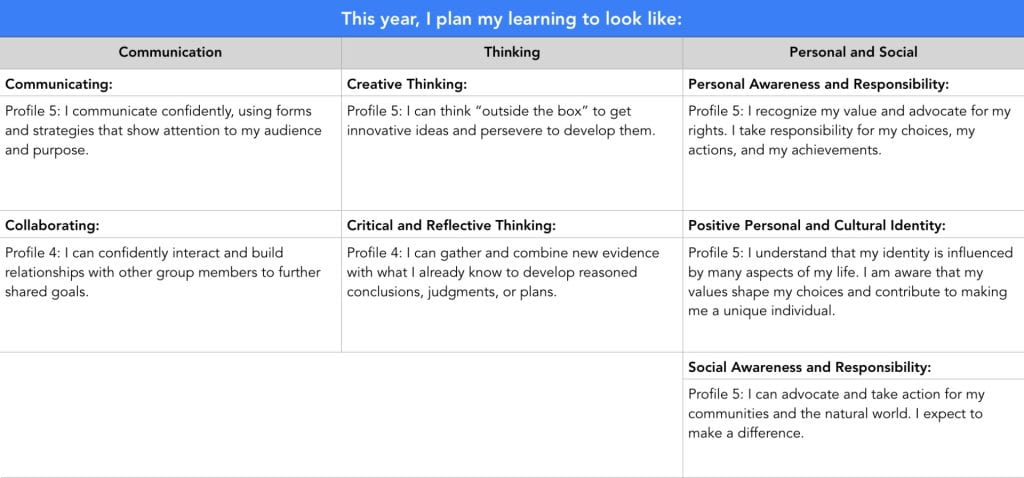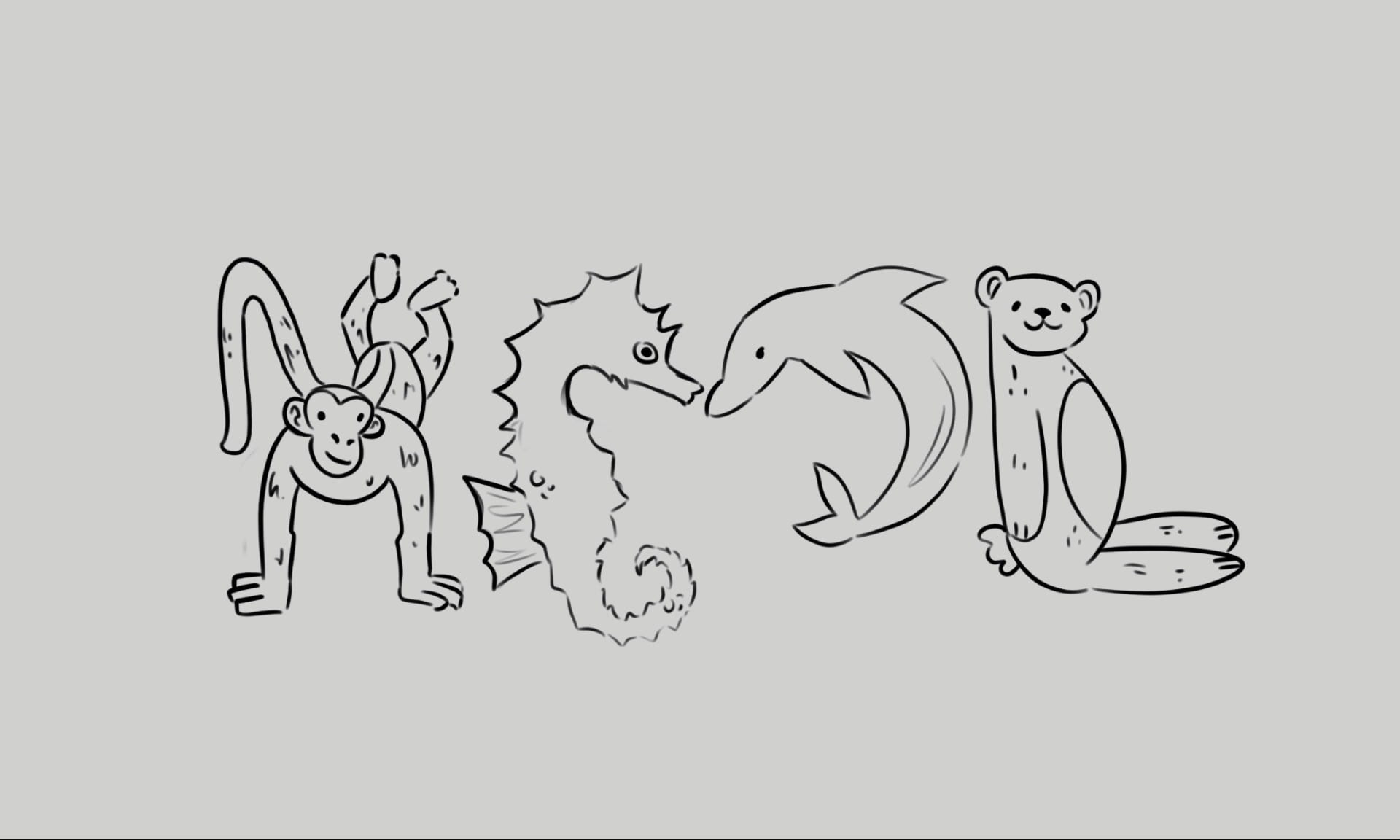MPOL Declaration
“Thank you for coming to my presentation of learning. I am the expert on my own learning. I am also responsible and accountable for my own learning. You can expect me to give an honest evaluation of my progress. We will discuss my strengths and opportunities for growth. Thank you in advance for listening and for offering feedback that I can use to improve as a learner.”
There are two driving questions I would like to answer in my MPOL today.
First of all: How have I demonstrated growth as a learner so far this year?
Secondly: How can I sharpen my learning plan to ensure that I reach my learning targets by the end of this school year?
What I LOVED and where I GREW!
So to answer the first driving question I want to talk about what I loved learning and where I showed growth in my learning during this first semester.
-
Loon Lake was an experience I loved and showed personal growth. I loved the Pinnacle Pursuit activities such as rock climbing, hike, and ropes courses. My intention for Loon Lake was to try everything. I wanted to take risks and gain new skills and experiences. My Loon Lake showed growth in my personal and social core competencies.

-
-
I grew in the personal awareness and responsibility aspect. At Loon Lake I identified my strengths and came up with intentions for every day and smart goals for this semester and year.
-
One of my intentions that shows personal growth was to try and complete all the activities we did. At the rock wall, I completed the easier wall at first without any problems. The second time around, I tried the harder wall and got stuck. It was cold, I had no gloves or coat on, but I never asked to come down. I complained about the cold but managed to make it to the top.
-
 One of my smart goals was to get 3 extending in Humanities this semester. As of this moment, I have earned 4.
One of my smart goals was to get 3 extending in Humanities this semester. As of this moment, I have earned 4. -
 The other smart goal, I accomplished this semester was to learn snowboarding, and be able to complete a run without falling on my face. Sadly, I never completed a run without face planting or losing my snowboard in a ravine, but I was close.
The other smart goal, I accomplished this semester was to learn snowboarding, and be able to complete a run without falling on my face. Sadly, I never completed a run without face planting or losing my snowboard in a ravine, but I was close.
-
-
-
GOLD Digger was a project I loved and helped me grow in my core competency, Critical, Creative and reflective Thinking. I enjoyed writing a story for the gold project and felt like I really grew in my research and writing skills.
-
I needed to research the main events of the BC Gold Rush and how it affected and shaped BC. We searched through many sources, looked at infographics, and watched a documentary. These sources helped me with my core competency skills related to thinking.
-

-
-
Using the research of the people at that time, I had to create a Hawaiian Gold Digger that could have existed. Designing a character card and writing a story off of our character card helped me practice my creative thinking skills.
-
My blog post on how I understood that the extent of how much the Gold Rush shaped BC, gave me a chance to show reflective thinking. The story format helped me really learn the information and think back on it.
-
-
The Komagata Maru Monument was also something I loved creating and felt like my core competencies for communicating showed growth.

-
-
The monument itself is a way of communication. The design shows my learning in a creative way. A lot of thought went into the symbols and projection of the symbols.
- https://youtu.be/5lO6ZvqQ2fQ
- This project required me to collaborate and communicate with my teammates. As my teammates were two people I felt familiar with and could rely on, we were able to come up with lots of ideas to reach a final product we could be proud of. Everyone met deadlines and was responsible for their parts.
-

-
-
I felt like I stepped up my communication skills at the exhibition when I explained to people passing by what our project was meant to represent.
-
-
Other specific areas of growth I am proud about are in work strategies, and collaboration.
-
I go to LAC every morning, use the THINGS app consistently, and am proactive in asking for extensions
-
I really improved on my collaborative skills this semester not only in the exhibition project but also just in small class activities. In Grade 8 I would not have asked my PLP friends for critique outside of critique time. But now I feel more comfortable asking my friends in the class for feedback with blog posts, key not videos and even asking for random decorations like the drawing at the top of this post which was made by Ariane.
-
To answer the second driving question, I want to talk about my learning target or where I need to grow
-
English Skills: I would like to improve my grammar and sentence structure.My dyslexia is the main reason I have many people check over my grammar and spelling. It is difficult for my brain to recognize if something is missing or out of order. Even though I have gotten better about asking for peer critique, I would like to improve myself in the area. For example, the comma and apostrophe literally look the same to me. I not only don’t really see the difference but I can’t remember which name goes with which one!
-
Risk Factor: One long term goal for myself this year is to show more personality in my work I enjoy my project but I don’t think my blogs fully show that and I want to have my work seem more authentic and not just like its a school assignment. It is challenging for me to get time to show more personality as I am stressed about getting things done on time.
-
Communicating with teachers in group work: I would like to improve in communicating with my teachers, when my group hits a roadblock. In Romeo and Juliet, I was excited about the project. No one would meet after school, before school. They also would not have any helpful suggestions about when we could meet to get it done. When we did set a time before school, only Ariane came on time. The other group members came almost when the tutorial time was done. I was very proud of my theme book for Romeo and Juliet but not with the final video.
Another part of answering the second driving question is to plan for how I am going to reach my learning targets
-
I will investigate apps for dyslexic students such as picture grammar to start – it may look like it is designed for 4 year olds, but hey, my confidence could use a boost.
-
communicate with teachers more regarding extensions and reducing work load
-
communication in class raising my hand more, goal once per week. The main reason why I don’t put up my hand, is because with my dyslexia and processing, words don’t come out the way I want them to come out. I can think them, but something else entirely comes out.
-
Adding personality to my work through photos and humour and trying different sentences in blog posts.


 The main challenge in making our visual was finding the best light source for inside our lantern. This was the part that I thought would be easy but the type of light mattered. Some were not strong enough which meant that the shapes were not projected clearly, and some duplicated the shapes so that they overlapped. In the end, we used the light on an iPhone to cast the perfect light.
The main challenge in making our visual was finding the best light source for inside our lantern. This was the part that I thought would be easy but the type of light mattered. Some were not strong enough which meant that the shapes were not projected clearly, and some duplicated the shapes so that they overlapped. In the end, we used the light on an iPhone to cast the perfect light. There were about eight rooms and each room connected to a theme shown in Avatar that we also see in world history and even in our present. For example, my room theme was militarism and my group and I had to connect the idea of militarism to the Komagata Maru incident. How the Canadian government responded with militarism to the arrival of the Komagata Maru was represented visually in our exhibition room, the Combat Zone. On the night of the exhibition, all of the grades in my room were told to start setting up, as the Grade 9 had a layout and plan in mind. Unfortunately, the student who had created and posted the layout was sick and no one understood what he had drawn. We came up with several ideas and moved props around when we were told that we were in the wrong place. After relocating, we found we were missing two of the tarps needed for the plan. Another challenge was finding the right spot for our specific monument. We needed less light
There were about eight rooms and each room connected to a theme shown in Avatar that we also see in world history and even in our present. For example, my room theme was militarism and my group and I had to connect the idea of militarism to the Komagata Maru incident. How the Canadian government responded with militarism to the arrival of the Komagata Maru was represented visually in our exhibition room, the Combat Zone. On the night of the exhibition, all of the grades in my room were told to start setting up, as the Grade 9 had a layout and plan in mind. Unfortunately, the student who had created and posted the layout was sick and no one understood what he had drawn. We came up with several ideas and moved props around when we were told that we were in the wrong place. After relocating, we found we were missing two of the tarps needed for the plan. Another challenge was finding the right spot for our specific monument. We needed less light